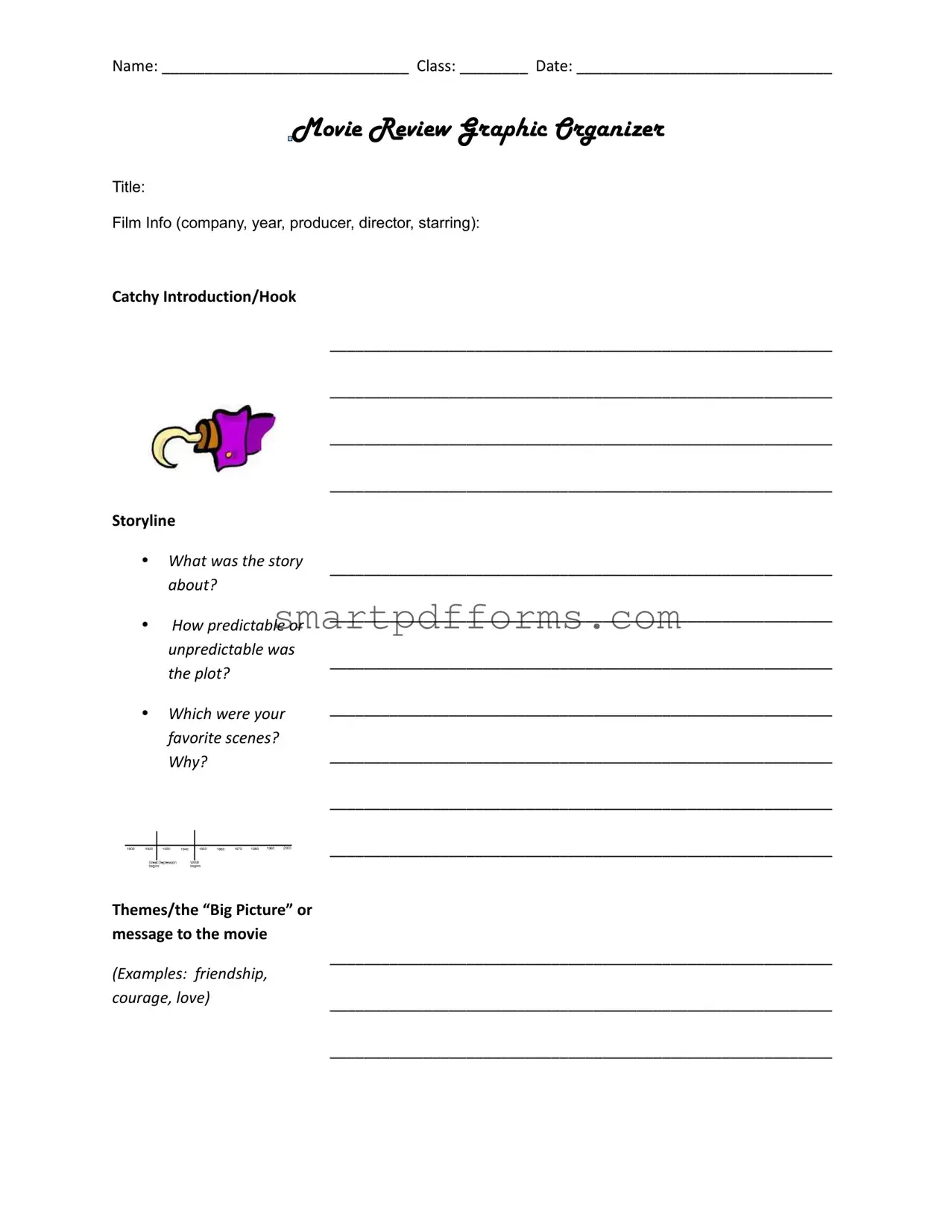Name: _____________________________ Class: ________ Date: ______________________________
Movie Review Graphic Organizer
Title:
Film Info (company, year, producer, director, starring):
Catchy Introduction/Hook
___________________________________________________________
___________________________________________________________
___________________________________________________________
___________________________________________________________
Storyline
•What was the story about?
•How predictable or unpredictable was the plot?
•Which were your favorite scenes? Why?
Themes/the “Big Picture” or message to the movie
(Examples: friendship,
courage, love)
___________________________________________________________
___________________________________________________________
___________________________________________________________
___________________________________________________________
___________________________________________________________
___________________________________________________________
___________________________________________________________
___________________________________________________________
___________________________________________________________
___________________________________________________________
Name: _____________________________ Class: ________ Date: ______________________________
Key Characters and their Roles within the Film
•Why was the main character likeable or not likeable?
•What made the actors convincing or unconvincing?
•Which conversation or dialogue did you enjoy the most?
Why?
What I liked (and proof)
___________________________________________________________
___________________________________________________________
___________________________________________________________
___________________________________________________________
___________________________________________________________
___________________________________________________________
___________________________________________________________
___________________________________________________________
___________________________________________________________
___________________________________________________________
___________________________________________________________
___________________________________________________________
___________________________________________________________
___________________________________________________________
___________________________________________________________
___________________________________________________________
___________________________________________________________
___________________________________________________________
___________________________________________________________
Name: _____________________________ Class: ________ Date: ______________________________
What I disliked (and proof)
___________________________________________________________
___________________________________________________________
___________________________________________________________
___________________________________________________________
___________________________________________________________
___________________________________________________________
___________________________________________________________
___________________________________________________________
___________________________________________________________
Filmmaking Techniques |
|
• |
Lighting |
___________________________________________________________ |
|
|
• |
Music |
___________________________________________________________ |
|
|
• |
Action |
|
|
|
___________________________________________________________ |
•Camera angles
• |
|
___________________________________________________________ |
Special Effects |
|
|
(sound and visual) |
___________________________________________________________ |
|
|
|
|
___________________________________________________________ |
|
|
___________________________________________________________ |
|
|
___________________________________________________________ |
|
|
___________________________________________________________ |
Name: _____________________________ Class: ________ Date: ______________________________
|
|
|
___________________________________________________________ |
Your Opinions |
|
|
|
|
___________________________________________________________ |
|
|
|
___________________________________________________________ |
|
|
|
___________________________________________________________ |
|
|
|
___________________________________________________________ |
|
|
|
___________________________________________________________ |
Closing: |
|
Movie Recommendation |
|
- Be sure to give an |
___________________________________________________________ |
overall rating or star |
|
listing for this film. List |
___________________________________________________________ |
whether or not you |
|
would view it again by |
___________________________________________________________ |
giving it a thumbs up |
|
|
|
or a thumbs down |
___________________________________________________________ |
|
|
|
|
|
|
___________________________________________________________ |
. |
|
|
|
|
|
|
|
|
|




